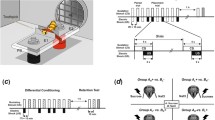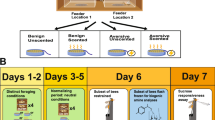Abstract
Physiological mechanisms of antennal sucrose perception in the honey bee were analysed using behavioural and electrophysiological methods. Following sucrose stimulation of the tip of a freely moving antenna, the latency of proboscis extension was 320–340 ms, 80–100 ms after the first activity in muscle M17 controlling this response. When bees were allowed to actively touch a sucrose droplet with one antenna, contacts with the solution were frequent with durations of 10–20 ms and average intervals between contacts of approximately 40 ms. High sucrose concentrations led to short and frequent contacts. The proboscis response and M17 activity were largely independent of stimulus duration and temporal pattern. Taste hairs of the antennal tip displayed spike responses to sucrose concentrations down to at least 0.1%. The first 25 ms of the response were suitable for discrimination of sucrose concentrations. This time interval corresponds to the duration of naturally occurring gustatory stimuli. Sucrose responses between different hairs on the same antenna showed a high degree of variability, ranging from less than five to over 40 spikes per 0.5 s for a stimulus of 0.1% sucrose. This variability of receptor responses extends the dynamic range of sucrose perception over a large range of concentrations.







Similar content being viewed by others
References
Almaas TJ, Christensen TC, Mustaparta H (1991) Chemical communication in heliotine moths. I. Antennal receptor neurons encode several features of intra- and interspecific odorants in the male corn earworm moth Helicovepra zea. J Comp Physiol A 169:249–258
Baldi P, Heiligenberg W (1988) How sensory maps could enhance resolution through ordered arrangements of broadly tuned receivers. Biol Cybern 59:313–318
Bitterman ME, Menzel R, Fietz A, Schäfer S (1983) Classical conditioning of proboscis extension in honeybees (Apis mellifera). J Comp Psychol 92:107–119
Coles JA, Orkand RA (1983) Modification of potassium movement through the retina of the drone (Apis mellifera) by glial uptake. J Physiol (Lond) 340:157–174
Erber J, Pribbenow B, Bauer A, Kloppenburg P (1993) Antennal reflexes in the honeybee: tools for studying the nervous system. Apidologie 24:283–296
Erber J, Kierzek S, Sander E, Grandy K (1998) Tactile learning in the honeybee. J Comp Physiol A 183:737–744
Esslen J, Kaissling K-E (1976) Zahl und Verteilung antennaler Sensillen bei der Honigbiene (Apis mellifera L.). Zoomorphologie 83:227–251
Gould JL (1985) Learning and memory in honey bees. In: Weinberger NM, McGaugh JL, Lynch J (eds) Memory systems of the brain, Guilford Press, New York, pp 193–210
Grosmaitre X, Marion-Poll F, Renou M (2001) Biogenic amines modulate olfactory receptor neurons firing activity in Mamestra brassicae. Chem Senses 26:653–661
Hansen-Delkeskamp E (2001) Responsiveness of antennal taste hairs of the apterygotan insect, Thermobia domestica (Zygentoma); an electrophysiological investigation. J Insect Physiol 47:689–697
Hansen-Delkeskamp E, Hansen K (1995) Responses and spike generation in the largest antennal taste hairs of Periplaneta brunnea Burm. J Insect Physiol 41:773–781
Hill ES, Okada K, Kanzaki R (2003) Visualization of modulatory effects of serotonin in the silkmoth antennal lobe. J Exp Biol 206:345–352
Hiroi M, Marion-Poll F, Tanimura T (2002) Differentiated response to sugars among labellar chemosensilla in Drosophila. Zool Sci 19:1009–1018
Hodgson ES, Lettvin JY, Roeder KD (1955) Physiology of a primary chemoreceptor unit. Science 122:417–418
Kisch J, Erber J (1999) Operant conditioning of antennal movements in the honey bee. Behav Brain Res 99:93–102
Kloppenburg P, Hildebrand JG (1995) Neuromodulation by 5-hydroxytryptamine in the antennal lobe of the sphinx moth Manduca sexta. J Exp Biol 198:603–611
Lacher V (1964) Elektrophysiologische Untersuchungen an einzelnen Rezeptoren für Geruch, Kohlendioxyd, Luftfeuchtigkeit und Temperatur auf den Antennen der Arbeitsbiene und der Drohne (Apis mellifera L.). Z Vergl Physiol 48:587–623
Marion-Poll F, Tobin TR (1992) Temporal coding of pheromone pulses and trains in Manduca sexta. J Comp Physiol A 171:505–512
Marshall J (1935) On the sensitivity of the chemoreceptors on the antenna and fore-tarsus of the honey-bee, Apis mellifica L. J Exp Biol 12:17–26
Menzel R and Müller U (1996) Learning and memory in honeybees: from behavior to neural substrates. Annu Rev Neurosci 19:379–404
Menzel R, Heyne A, Kinzel C, Gerber B, Fiala A (1999) Pharmacological dissociation between the reinforcing, sensitizing, and response-releasing functions of reward in honeybee classical conditioning. Behav Neurosci 113:744–754
Morita H, Shiraishi A (1985) Chemoreception physiology. In: Kerkut GA, Gilbert LI (eds) Comprehensive insect physiology, biochemistry, and pharmacology vol 6. Nervous system: sensory. Pergamon Press, Oxford, pp 133–170
Murlis J (1986) The structure of odour plumes. In: Payne TL, Birch MC, Kennedy CEJ (eds) Mechanisms of insect olfaction, Clarendon Press, Oxford, pp 27–38
Page RE, Erber J (2002) Levels of behavioral organization and the evolution of division of labor. Naturwissenschaften 89:91–106
Page RE, Erber J, Fondrk MK (1998) The effect of genotype on response thresholds to sucrose and foraging behavior of honey bees (Apis mellifera L.). J Comp Physiol A 182:489–500
Pankiw T, Page RE (1999) The effect of genotype, age, sex, and caste on response thresholds to sucrose and foraging behavior of honey bees (Apis mellifera L.). J Comp Physiol A 185:207–213
Pophof B (2000) Octopamine modulates the sensitivity of silkmoth pheromone receptor neurons. J Comp Physiol A 186:307–313
Pribbenow B, Erber J (1996) Modulation of antennal scanning in the honeybee by sucrose stimuli, serotonin, and octopamine: behavior and electrophysiology. Neurobiol Learn Mem 66:109–120
Rehder V (1987) Quantification of the honeybee’s proboscis reflex by electromyographic recordings. J Insect Physiol 33:501–507
Rumbo ER, Kaissling K-E (1989) Temporal resolution of odour pulses by three types of pheromone receptor cells in Antherea polyphemus. J Comp Physiol A 165:281–291
Scheiner R, Erber J, Page RE (1999) Tactile learning and the individual evaluation of the reward in honey bees (Apis mellifera L.). J Comp Physiol A 185:1–10
Scheiner R, Page RE, Erber J (2001) The effects of genotype, foraging role, and sucrose responsiveness on the tactile learning performance of honey bees (Apis mellifera L.). Neurobiol Learn Mem 76:138–150
Schmitt BC, Ache BW (1979) Olfaction: responses of a decapod crustacean are enhanced by flicking. Science 205:204–206
Schnuch M, Hansen K (1990) Sugar sensitivity of a labellar salt receptor of the blowfly Protophormia terraenovae. J Insect Physiol 36:409–417
Simpson SJ, Simpson CL (1992) Mechanisms controlling modulation by haemolymph amino acis of gustatory responsiveness in the locust. J Exp Biol 168:269–287
Snodgrass RE (1956) Anatomy of the honey bee. Comstock, Ithaca
Suzuki H (1975) Antennal movements induced by odor and central projections of the antennal neurons in the honey bee. J Insect Physiol 21:831–847
Whitehead AT (1978) Electrophysiological responses of honey bee labial palp contact chemoreceptors to sugars and electrolytes. Physiol Entomol 3:241–248
Whitehead AT, Larsen JR (1976a) Ultrastructure of the contact chemoreceptors of Apis mellifera L. (Hymenoptera: Apidae). Int J Insect Morphol Embryol 5:301–315
Whitehead AT, Larsen JR (1976b) Electrophysiological responses of galeal contact chemoreceptors of Apis mellifera to selected sugars and electrolytes. J Insect Physiol 22:1609–1616
Wieczorek H, Köppl R (1978) Effect of sugars on the labellar water receptor of the fly. J Comp Physiol A 126:131–136
Yokohari F (1983) The coelocapitular sensillum, an antennal hygro- and thermoreceptive sensillum of the honey bee, Apis mellifera L. Cell Tissue Res 233:355–365
Yokohari F, Tominaga Y, Tateda H (1982) Antennal hygroreceptors of the honey bee, Apis mellifera L. Cell Tissue Res 226:63–73
Acknowledgements
The author is grateful to M. de Bruyne and C. Kleineidam for discussions concerning sensilla, to S. Berger for help with some of the data analyses, to R. Scheiner for suggestions concerning the manuscript, and to J. Erber for support and extensive comments on various versions of the manuscript. This project was supported by the SFB 515 of the Deutsche Forschungsgemeinschaft. Experiments were conducted in accordance with the laws concerning animals experiments of the Federal Republic of Germany.
Author information
Authors and Affiliations
Corresponding author
Rights and permissions
About this article
Cite this article
Haupt, S.S. Antennal sucrose perception in the honey bee (Apis mellifera L.): behaviour and electrophysiology. J Comp Physiol A 190, 735–745 (2004). https://doi.org/10.1007/s00359-004-0532-5
Received:
Revised:
Accepted:
Published:
Issue Date:
DOI: https://doi.org/10.1007/s00359-004-0532-5




